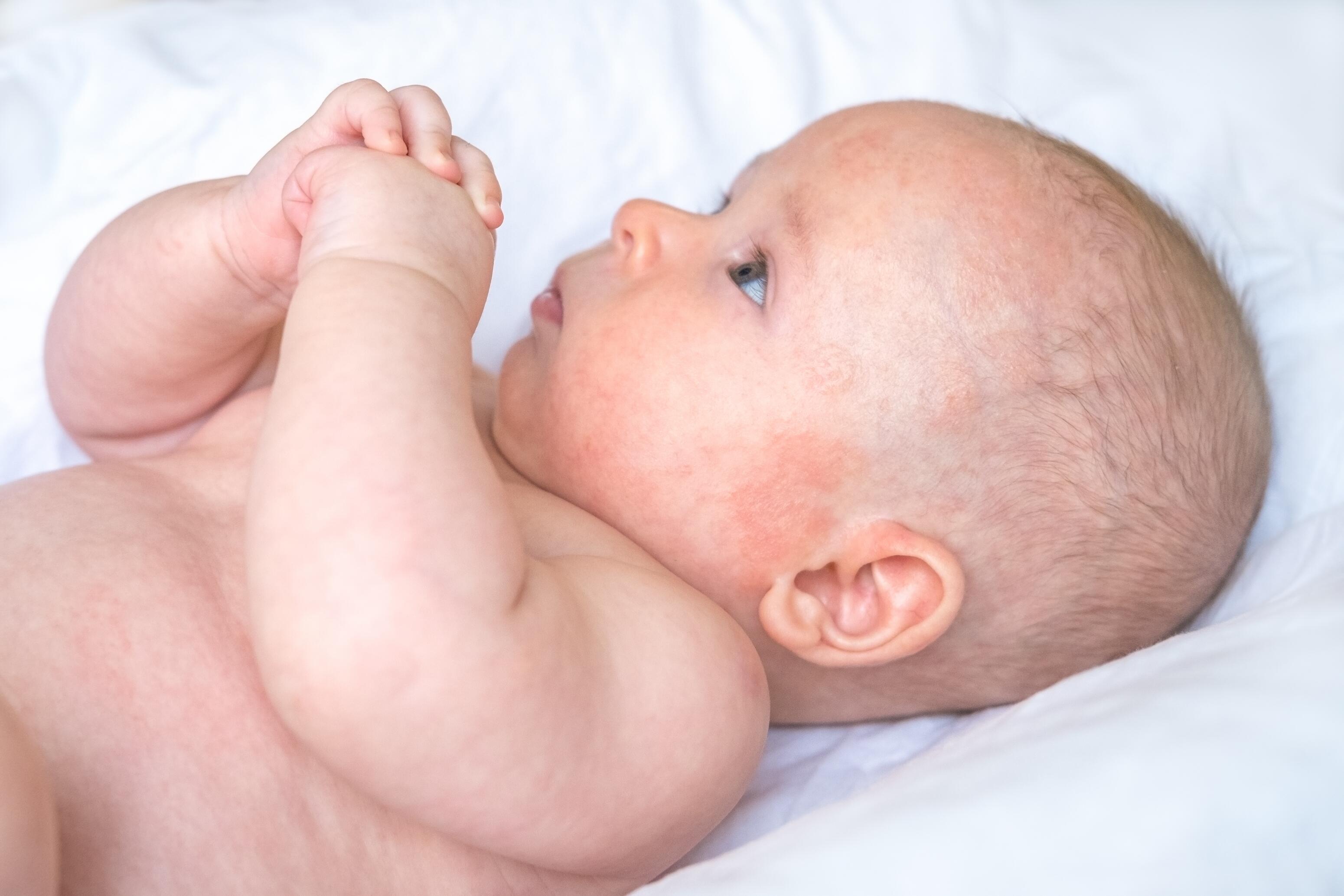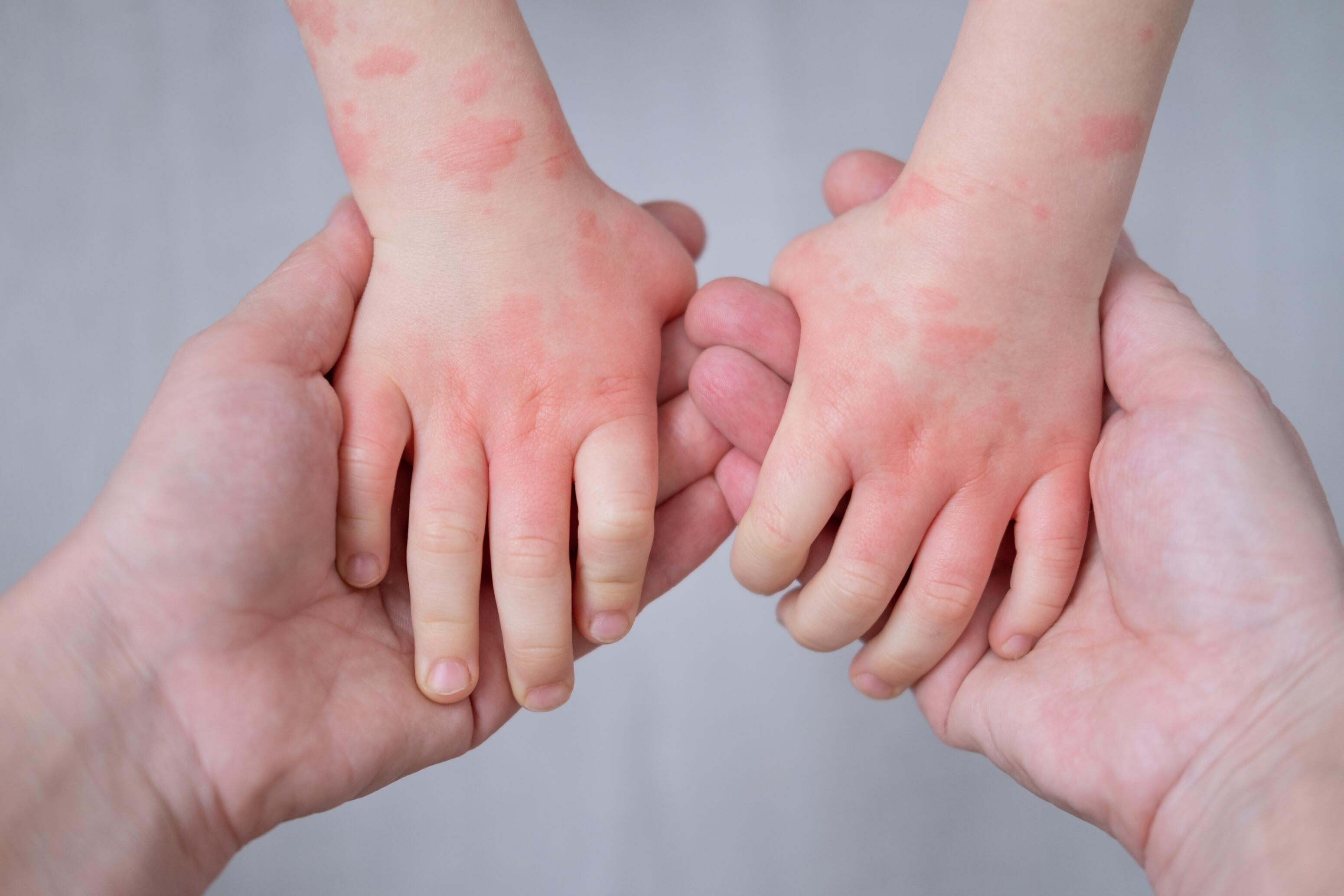Managing eczema in babies
Eczema in babies is characterized by itching and redness. How can you recognise the symptoms and take care of your child's skin ?
What are the symptoms of eczema in babies ?
Identifying signs of eczema flare-ups in infants¹ ² ³
Infant eczema, or atopic dermatitis, manifests in cycles of inflammatory flare-ups and remission periods.
During flare-ups, typical symptoms include:
- Skin dryness, exacerbating discomfort for the baby.
- Severe itching (pruritus), leading to disrupted sleep and a tendency for the infant to persistently rub affected areas against bedding or clothing.
- Characteristic eczema lesions: red, rough, and swollen plaques, which may display vesicles that rupture and form crusts.
Classic symptoms of atopic dermatitis
Itching
Skin lesions

Common locations of eczema lesions in infants¹ ² ³
The usual sites for atopic dermatitis lesions in babies include:
- The face, particularly cheeks, chin, and forehead.
- The scalp
- Limbs’ extensor regions, notably around the knees and elbows.
- The anterior neck fold and area behind the ears, often exhibiting cracks and oozing.
Eczema in babies typically avoids areas such as the palms, soles, nose, and diaper region. The pattern of lesions can vary among infants and often shifts to the flexural areas, like the inner elbows and knees, as the child grows.
Causes of eczema in infants¹ ² ³
The emergence of atopic dermatitis in infants is influenced by a complex interplay of genetic, immune, and environmental factors.
Genetic factors
Eczema has a pronounced genetic predisposition. Research indicates that if one parent has a history of atopic conditions, including eczema, their child faces a 50 to 70% increased risk of developing the condition. Key among the implicated genes are those responsible for the production of filaggrin, a vital protein for maintaining skin barrier integrity.
In infants with eczema, a deficiency in this protein and the resultant loss of the natural hydrolipidic film can lead to increased water loss through the skin. This disruption in skin barrier function, compounded by filaggrin anomalies, leaves the skin dry and more susceptible to penetration by allergenic substances, sparking inflammatory responses.
Immune system abnormalities
Infants suffering from atopic dermatitis exhibit an unusually reactive immune system. This hyperactivity is characterized by the production of excessive levels of IgE antibodies in response to common environmental allergens.
Environmental triggers
Environmental elements are critical in both the onset and aggravation of atopic dermatitis in infants. Everyday irritants, such as soaps, detergents, fragrances, and wool, alongside temperature fluctuations, can intensify eczema symptoms. Certain food allergens can trigger or exacerbate eczema in predisposed infants. Exposure to air pollution and tobacco smoke also contributes to the risk of developing eczema.

Irritants to avoid in atopic dermatitis in babies
Soap
Fragrance
Wool
Temperatures variations
Differentiating eczema from other infant skin conditions
Seborrheic dermatitis⁴ ⁵
Seborrheic dermatitis, often called 'cradle cap' in infants, is a distinct condition from eczema. It typically manifests in areas rich in sebaceous glands, like the scalp and face, presenting as salmon-pink patches blanketed in thick, oily scales of white or yellow hue. While it may co-occur with eczema, seborrheic dermatitis typically lacks associated scratching marks and doesn't usually disturb sleep.
Psoriasis⁴ ⁵
Both eczema and psoriasis in infants are chronic, inflammatory skin disorders, yet psoriasis is marked by firm red plaques covered in silvery-white scales. Rare in infants, psoriasis initially targets the diaper area, resembling diaper rash but with clear-cut boundaries.
Common sites for psoriasis include extensor surfaces like elbows and knees, and the thumb in infants who suck their thumb (often referred to as the 'thumb sign').
Irritant contact dermatitis⁴ ⁵
In infants, irritant contact dermatitis often emerges on the face, especially around the mouth, as well as on the hands and diaper area. It's frequently triggered by ongoing cycles of skin wetting and drying and exposure to irritants like saliva, urine, feces, cleansers, and certain foods.
Scabies⁴ ⁵
Scabies, caused by the Sarcoptes scabiei mite, typically affects the palms, soles, face, and scalp in infants.
Unlike eczema, scabies is a contagious disease, often spreading to other family members. The lesions don't exhibit the dryness seen in eczema, and scabies burrows, or linear marks made by the mite, may be visible on examination.
Impetigo⁴ ⁵
Impetigo, a common superficial bacterial skin infection in infants, usually develops on minor skin injuries such as wounds, irritations, or existing dermatitis. It's characterized by redness, swelling, and distinctive honey-colored crusts.
Candidiasis⁴ ⁵
Candidiasis, a fungal infection caused by Candida Albicans, typically affects the warm, moist regions of an infant's body, particularly the diaper area and skin folds. It can cause itching, but not the intense pruritus commonly associated with eczema.
Different skin infections in infants
Seborrheic dermatitis
Psoriasis
Irritant contact dermatitis⁴ ⁵
Scabies
Impetigo
Candidiasis
Managing and treating infant eczema² ³ ⁶ ⁷
The treatment atopic dermatitis in babies is primarily symptomatic, focusing on alleviating symptoms during outbreaks and minimizing the occurrence of new episodes.
Moisturizing
Moisturizing is the cornerstone of treatment. It restores the skin barrier and prevents dryness, reducing itching, irritation, and the frequency of flare-ups.
Moisturize your baby's skin by applying an emollient twice daily over the entire body, with increased emphasis during winter months when the skin is more susceptible to dryness.
Topical corticosteroids
Topical corticosteroids effectively reduce inflammation during atopic eczema flare-ups. They should be applied once a day to the affected areas.
Their potency is determined by the doctor as per the severity of the symptoms and the location of lesions. Adhering to the doctor's prescription is crucial.
Additional treatments
In some cases, further treatments may be required for infant eczema, such as antibiotics for bacterial superinfections or specialized therapies for more severe conditions.
Treatment for infants
Moisturizing
Topical corticosteroïds
Additional treatments
Preventive measures for eczema flare-ups in babies² ³ ⁷ ⁸
Implementing certain practices is crucial for averting eczema flare-ups in your baby.
Managing eczema in babies
Adopt these measures to minimize skin irritation:
1. Suitable bath products: use soap-free, liquid cleansers with a neutral pH and suitable lipid levels. Alkaline soaps can be overly abrasive for an infant's delicate skin.
2. Moderate water temperature: aim for lukewarm water, ideally between 27 to 30°C, to safeguard your baby's skin.
3. Limit bath time: Keep baths short, about 5 minutes, to prevent the skin from drying out. Bath oils formulated for infants can help retain moisture.
4. Gentle cleansing: Clean your baby's skin gently to remove crusts and bacterial contaminants, especially if there’s a superinfection.
5. Soft drying and emollient application: Pat your baby's skin dry with a soft towel and apply an emollient while the skin is still damp to lock in moisture.
6. Minimize environmental triggers: maintain a home environment with optimal humidity and a steady temperature around 18°C. Shield your baby from tobacco smoke and familiar allergens by ensuring proper air circulation.
7. Avoid contact irritants: choose cotton clothing and steer clear of wool or synthetic fibers. Rinse clothes thoroughly and avoid fragranced fabric softeners.
Strategies to prevent scratching
These gentle methods can help alleviate itching and prevent scratching in infants:
- Use of thermal water: spritz thermal water on irritated areas for a soothing effect, followed by a moisturizing application.
- The soothing effect of cold: cold can help alleviate itching. Consider using a chilled thermal water compress or a refrigerated cooling gel pack for temporary relief.
- Wearing cotton gloves at night: for infants who scratch in their sleep, consider using small cotton gloves. This can help prevent accidental scratching and limit worsening of itching.
- Keeping nails short: Keeping your baby's nails short and smooth can prevent accidental scratching.
- Prepare for nighttime: apply an emollient cream before bedtime to reduce itching. Ensure your infant's bed is equipped with soft cotton sheets, keep the room well-ventilated and the temperature around 18°C.

FAQ
In the majority of cases, atopic dermatitis improves with age. Some people see their symptoms decrease considerably before puberty, while others may continue to have persistent symptoms.
References:
1. L’Assurance Maladie. Eczéma ou dermatite atopique : causes, symptômes et évolution. Ameli.fr. 2023 Sep. [Disponible sur :] https://www.ameli.fr/assure/sante/themes/eczema-atopique/reconnaitre-eczema-atopique
2. Nemeth V, Evans J. Eczema. National Library of Medicine. Août 2022. [Disponible sur :] https://www.ncbi.nlm.nih.gov/books/NBK538209/
3. Lyons JJ, Milner JD, Stone KD. Atopic dermatitis in children: clinical features, pathophysiology, and treatment. Immunol Allergy Clin North Am. 2015 Feb;35(1):161-83.
4. Barrett M, Luu M. Differential Diagnosis of Atopic Dermatitis. Immunol Allergy Clin North Am. 2017 Feb;37(1):11-34.
5. Siegfried EC, Hebert AA. Diagnosis of Atopic Dermatitis: Mimics, Overlaps, and Complications. J Clin Med. 2015 May 6;4(5):884-917.
6.L’Assurance Maladie. La consultation et le traitement en cas d'eczéma ou dermatite atopique. Ameli.fr. 2023 Sep. [Disponible sur :] https://www.ameli.fr/assure/sante/themes/eczema-atopique/consultation-traitement
7. Wollenberg A and al. European guideline (EuroGuiDerm) on atopic eczema - part II: non-systemic treatments and treatment recommendations for special AE patient populations. J Eur Acad Dermatol Venereol. 2022 Nov;36(11):1904-1926.
8. L’Assurance Maladie. Dermatite atopique : que faire et quand consulter ? Ameli.fr. 2023 Sep. [Disponible sur :] https://www.ameli.fr/assure/sante/themes/eczema-atopique/que-faire-quand-consulter
- Discover The Different Types of Eczema: How to Recognise Them?
The Different Types of Eczema: How to Recognise Them?
- Discover Eczema Symptoms: Identification and Understanding
Eczema Symptoms: Identification and Understanding




















